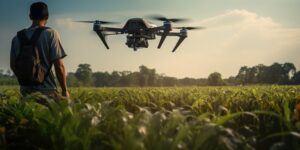Precision agriculture, also known as precision farming, represents a paradigm shift in the way modern agriculture is conducted. By leveraging advanced technologies, precision agriculture services provide farmers with the tools and insights needed to optimize crop yields, reduce inputs, and enhance sustainability. In the USA, precision agriculture is rapidly gaining traction, transforming traditional farming practices into a high-tech industry.
What Is Precision Agriculture?
Precision agriculture involves using technology to monitor and manage agricultural processes with a high degree of accuracy. The core idea is to ensure that crops and soil receive exactly what they need for optimal health and productivity. This approach contrasts with traditional methods that apply uniform treatments across entire fields, often leading to inefficiencies and waste.

Source: Freepik
Key Components of Precision Agriculture:
GPS and GNSS Technology:
GPS (Global Positioning System) and GNSS (Global Navigation Satellite System) are foundational technologies in precision agriculture. They enable farmers to create detailed field maps, track machinery, and apply inputs like fertilizers and pesticides with pinpoint accuracy.
Remote Sensing and Drones:
Remote sensing technologies, including satellites and drones, capture high-resolution images of fields. These images provide valuable data on crop health, soil conditions, and pest infestations. Drones, in particular, have become indispensable for their ability to quickly survey large areas and deliver real-time insights.
Variable Rate Technology (VRT):
Variable Rate Technology allows for the variable application of inputs based on specific field conditions. Using data from soil tests, yield monitors, and remote sensing, VRT systems adjust the amount of seeds, fertilizers, and pesticides applied in different parts of the field, ensuring optimal use and minimizing waste.
Soil and Crop Sensors:
Sensors placed in the soil and on plants measure a range of parameters, including moisture levels, nutrient content, and plant health. This real-time data helps farmers make informed decisions about irrigation, fertilization, and pest control.
Data Analytics and Software:
Advanced data analytics and farm management software are crucial for interpreting the vast amounts of data generated by precision agriculture technologies. These tools provide actionable insights, allowing farmers to make data-driven decisions that improve efficiency and productivity.
Benefits of Precision Agriculture Services:
Increased Crop Yields:
By precisely managing inputs and monitoring crop health, precision agriculture helps farmers maximize their yields. Targeted treatments ensure that each plant receives the right amount of nutrients and water, leading to healthier crops and higher productivity.
Cost Savings:
Precision agriculture reduces the over-application of fertilizers, pesticides, and water, leading to significant cost savings. Farmers can invest these savings in other areas of their operations, further enhancing profitability.
Environmental Sustainability:
Reducing the use of chemicals and optimizing resource use helps minimize the environmental impact of farming. Precision agriculture promotes sustainable practices that protect soil health, conserve water, and reduce greenhouse gas emissions.
Improved Resource Management:
With precise data on soil conditions and crop needs, farmers can manage their resources more effectively. This leads to better soil health, more efficient water use, and improved overall farm sustainability.
Enhanced Decision-Making:
Precision agriculture provides farmers with real-time data and predictive insights, enabling them to make better-informed decisions. This leads to more proactive and effective farm management, reducing risks and improving outcomes.
Challenges and Future Directions:
While precision agriculture offers numerous benefits, its adoption faces some challenges:
Cost of Technology:
The initial investment in precision agriculture technologies can be high, making it difficult for small and medium-sized farms to adopt these solutions. However, the long-term cost savings and productivity gains can offset these initial expenses.
Data Management:
Managing and interpreting the vast amounts of data generated by precision agriculture systems can be challenging. Farmers need user-friendly software and analytics tools to make sense of the data and apply it effectively.
Education and Training:
Farmers need education and training to effectively use precision agriculture technologies. Extension services, workshops, and online resources can help bridge this knowledge gap and promote wider adoption.
Despite these challenges, the future of precision agriculture looks promising. Advances in technology, such as artificial intelligence, machine learning, and IoT, are expected to further enhance precision agriculture capabilities. These innovations will make precision agriculture more accessible, affordable, and effective, driving its adoption across the USA.
Conclusion:
Precision agriculture services are revolutionizing modern farming in the USA, providing farmers with the tools and insights needed to optimize their operations. By leveraging advanced technologies like GPS, remote sensing, VRT, and data analytics, precision agriculture enhances crop yields, reduces costs, and promotes environmental sustainability. As technology continues to advance, the adoption of precision agriculture is set to grow, leading to a more efficient, productive, and sustainable agricultural industry. Farmers, agribusinesses, and policymakers must continue to support and invest in these technologies to ensure a resilient and prosperous future for agriculture.
To learn more about how SoilOptix® can propel your precision agriculture practices into success, contact us at www.soiloptix.com
